check engine CADILLAC ELDORADO 1998 10.G Owners Manual
[x] Cancel search | Manufacturer: CADILLAC, Model Year: 1998, Model line: ELDORADO, Model: CADILLAC ELDORADO 1998 10.GPages: 380, PDF Size: 21.39 MB
Page 21 of 380
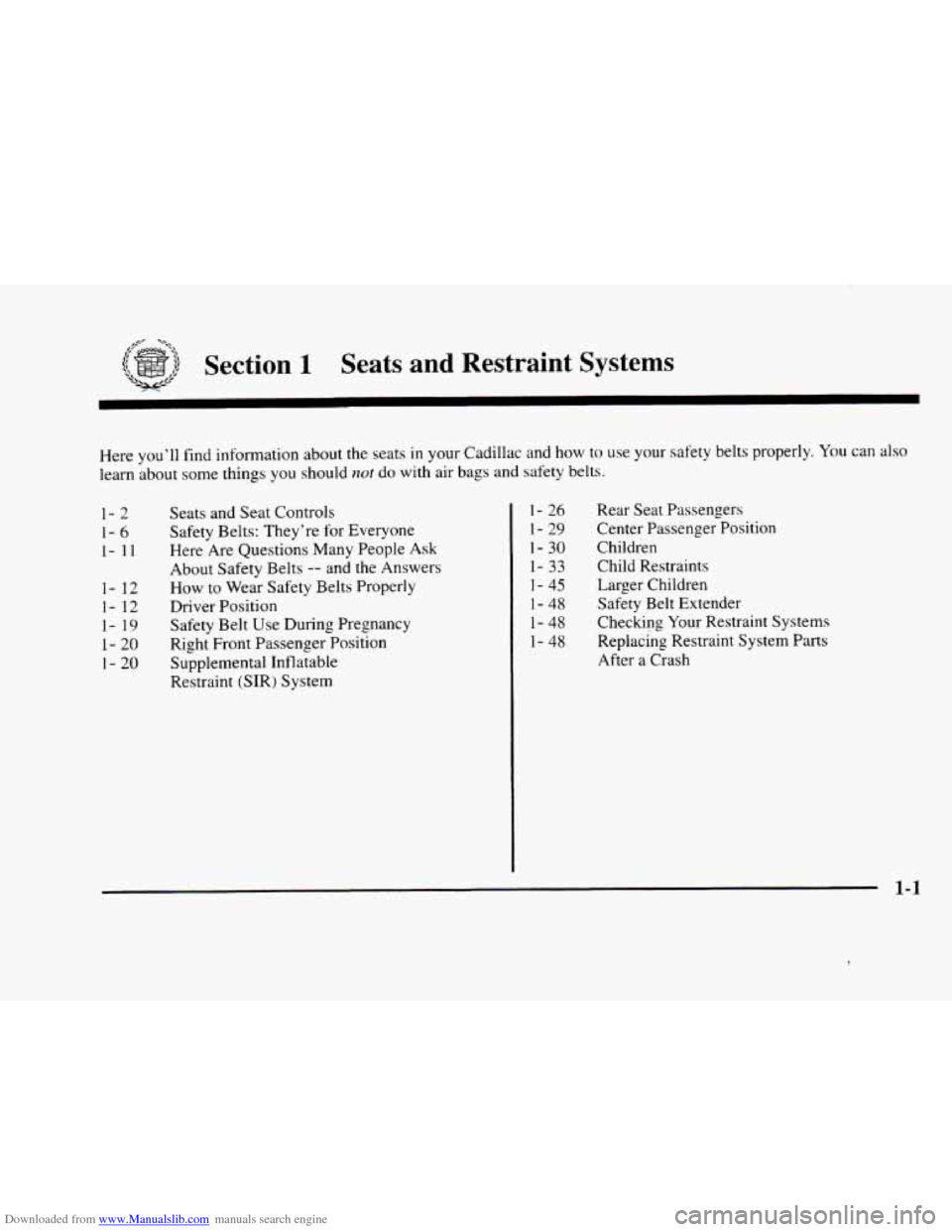
Downloaded from www.Manualslib.com manuals search engine Section 1 Seats and Restraint Systems
Here you’ll find information about the seats in your Cadillac and how to use your safety belts properly. You can also
learn about some things you should
not do with air bags and safety belts.
1- 2
1- 6
1- 11
1- 12
1- 12
1-
19
1- 20
1- 20
Seats and Seat Controls
Safety Belts: They’re for Everyone
Here Are Questions Many People Ask
About Safety Belts
-- and the Answers
How
to Wear Safety Belts Properly
Driver Position
Safety Belt Use During Pregnancy
Right Front Passenger Position
Supplemental Inflatable
Restraint
(SIR) System
1- 26
I- 29
I- 30
1- 33
1- 45
1- 48
1- 48
1- 48 Rear Seat
Passengers
Center Passenger Position
Children
Child Restraints
Larger Children
Safety Belt Extender
Checking Your Restraint Systems
Repiacing Restraint System Parts
After a Crash
1-1
Page 26 of 380
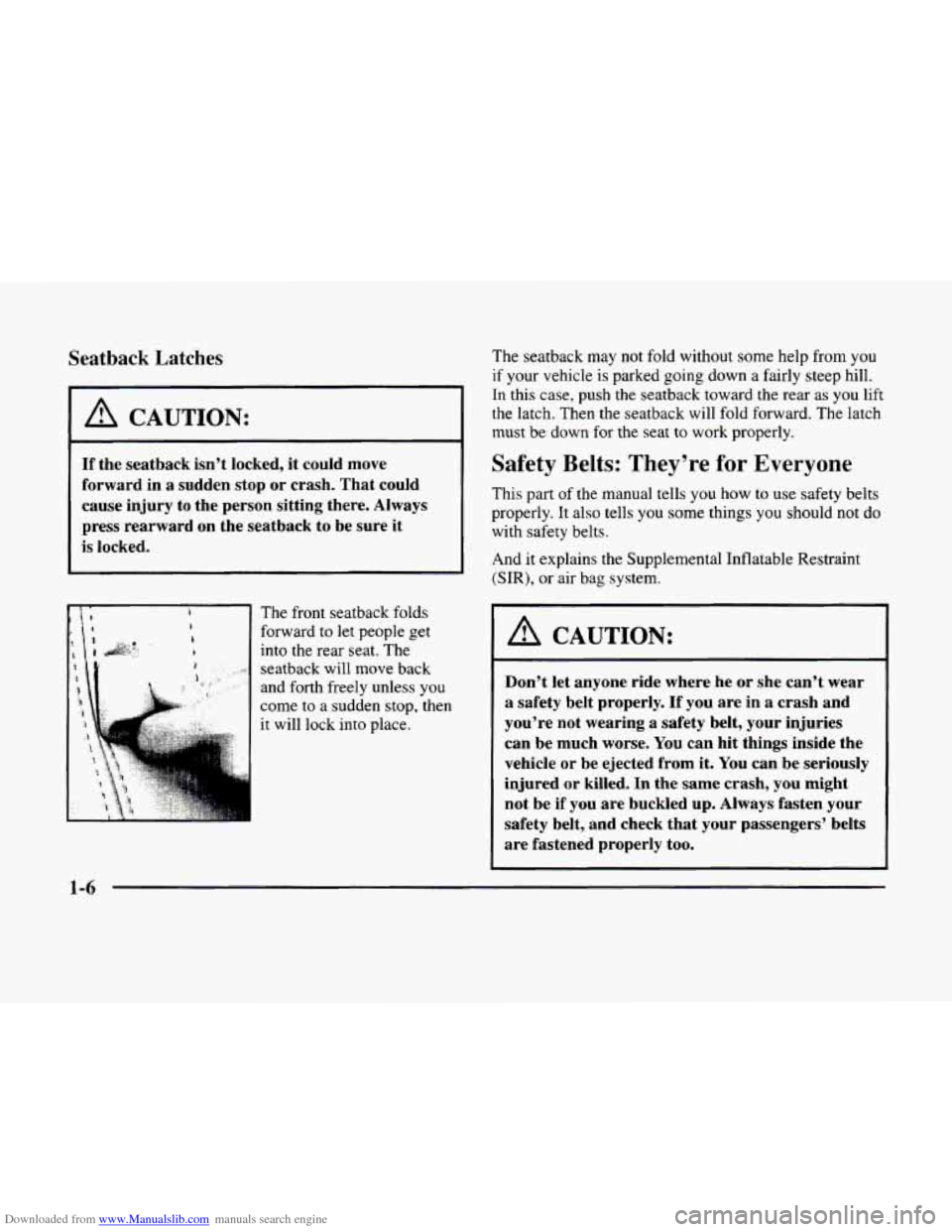
Downloaded from www.Manualslib.com manuals search engine Seatback Latches
I A CAUTION:
If the seatback isn’t locked, it could move
forward in a sudden stop or crash. That could
cause injury to the person sitting there. Always
press rearward on the seatback to be sure it
is locked.
The front seatback folds
forward to
let people get
into the rear seat. The
seatback will move back
and forth freely unless you
come to a sudden stop, then
it will lock into place. The
seatback may not fold without some help from
you
if your vehicle is parked going down a fairly steep hill.
In this case, push the seatback toward the rear as you lift
the latch. Then the seatback will fold forward. The latch
must be
down for the seat to work properly.
Safety Belts: They’re for Everyone
This part of the manual tells you how to use safety belts
properly. It also tells you some things
you should not do
with safety belts.
And it explains the Supplemental Inflatable Restraint
(SIR), or air bag system.
A CAUTION:
Don’t let anyone ride where he or she can’t wear
a safety belt properly.
If you are in a crash and
you’re not wearing a safety belt, your injuries
can be much worse.
You can hit things inside the
vehicle
or be ejected from it. You can be seriously
injured
or killed. In the same crash, you might
not be
if you are buckled up. Always fasten your
safety belt, and check that your passengers’ belts
are fastened properly too.
1-6
Page 41 of 380
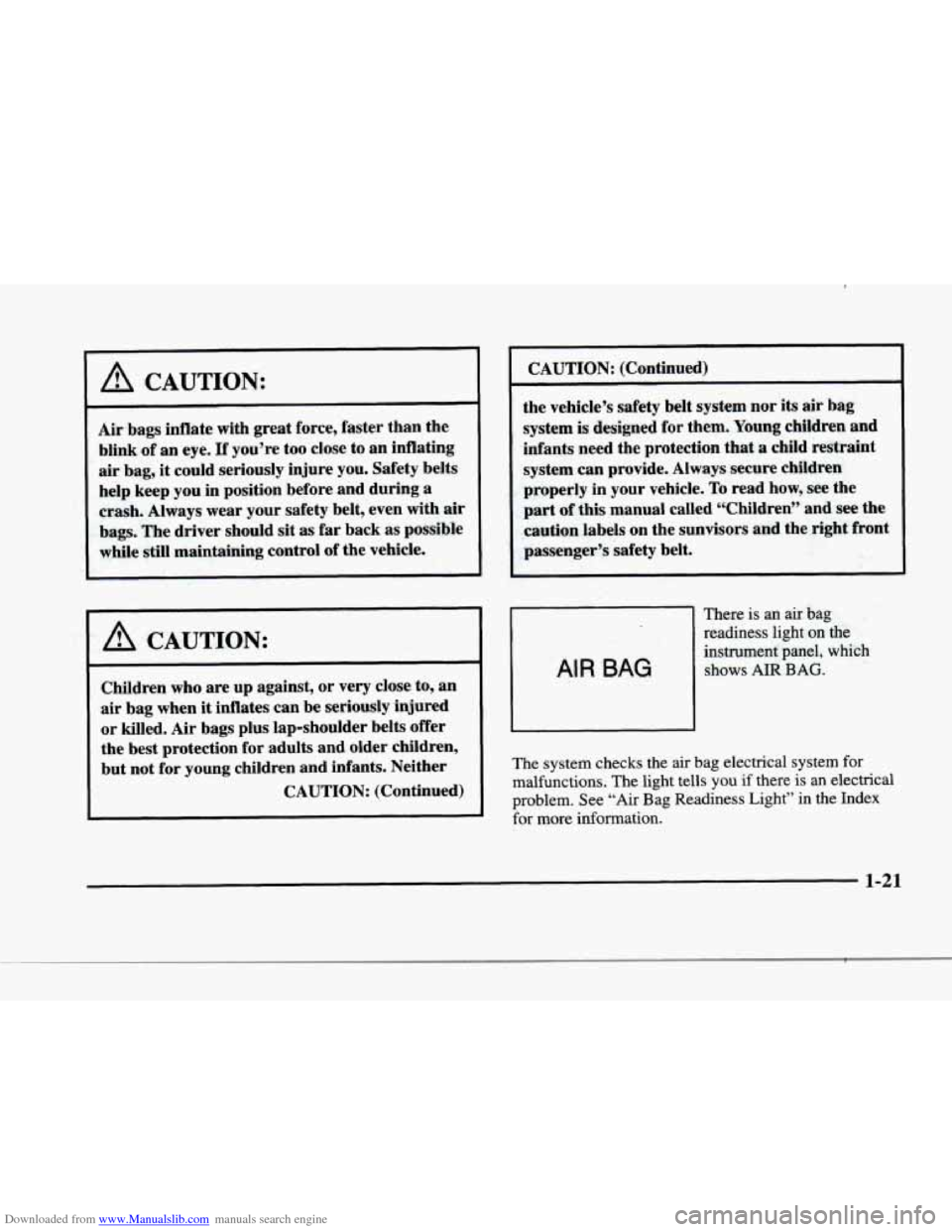
Downloaded from www.Manualslib.com manuals search engine r
r !
r
r
r
r
f- t
i
A CAUTION:
Air bags inflate with great force, faster than the
blink
of an eye. If you’re too close to an inflating
air bag, it could seriously injure you. Safety belts
help keep you in position before and during a
crash. Always wear your safety belt, even with
air
bags. The driver should sit as far back as possible
while
still maintaining control of the vehicle.
A CAUTION:
Children who are up against, or very close to, an
air bag when it inflates can be seriously injured
or killed. Air bags plus lap-shoulder belts offer
the best protection for adults and older children,
but not for young children and infants. Neither
CAUTION: (Continued) CAUTION: (Continued)
the vehicle’s safety belt system
nor its air bag
system
is designed for them. Young children and
infants need the protection that
a child restraint
system can provide. Always secure children
properly in your vehicle. To read how, see the
part of this manual called “Children” and see the
caution labels
on the sunvisors and the right front
passenger’s safety belt.
There is an air bag
readiness light on the
instrument panel, which
shows AlR BAG.
The system checks the air bag electrical system for
malfunctions. The light tells you if there is an electrical
problem. See “Air Bag Readiness Light” in
the Index
for more information.
1-21
Page 68 of 380

Downloaded from www.Manualslib.com manuals search engine Safety Belt Extender
If the vehicle’s safety belt will fasten around you, you
should use it.
But if
a safety belt isn’t long enough to fasten, your
dealer will order you an extender.
It’s free. When you go
in to order it, take the heaviest coat you will wear,
so the
extender will be long enough for you. The extender will
be just for you, and just for the seat
in your vehicle that
you choose. Don’t let someone else use it, and use it
only for the seat it is made to fit. To wear it, just attach it
to the regular safety belt.
Checking Your Restraint Systems
Now and then. make sure the safety belt reminder light
and all
your belts, buckles, latch plates, retractors and
anchorages are working properly. Look for any other
loose or damaged safety belt system parts.
If you see
anything that might keep a safety belt system from
doing its job, have
it repaired.
Torn or frayed safety belts may
not protect you in a
crash. They can rip apart under impact forces. If a belt is
torn or frayed, get
a new one right away.
Also look for any opened or broken air bag covers, and
have them repaired or replaced. (The air bag system
does not need regular maintenance.)
Replacing Restraint System Parts
After a
Crash
If you’ve had a crash, do you need new belts?
After
a very minor collision, nothing may be necessary.
But if the belts were stretched, as they would be if worn
during a more severe crash, then you need new belts.
If belts are cut or damaged, replace them. Collision
damage also may mean
you will need to have safety belt
or seat parts repaired or replaced. New parts and repairs
may be necessary even if the belt wasn’t being used at
the time of the collision.
If an air bag inflates, you’ll need to replace air bag
system parts. See the part on the air bag system earlier
in this section.
1-48
Page 76 of 380
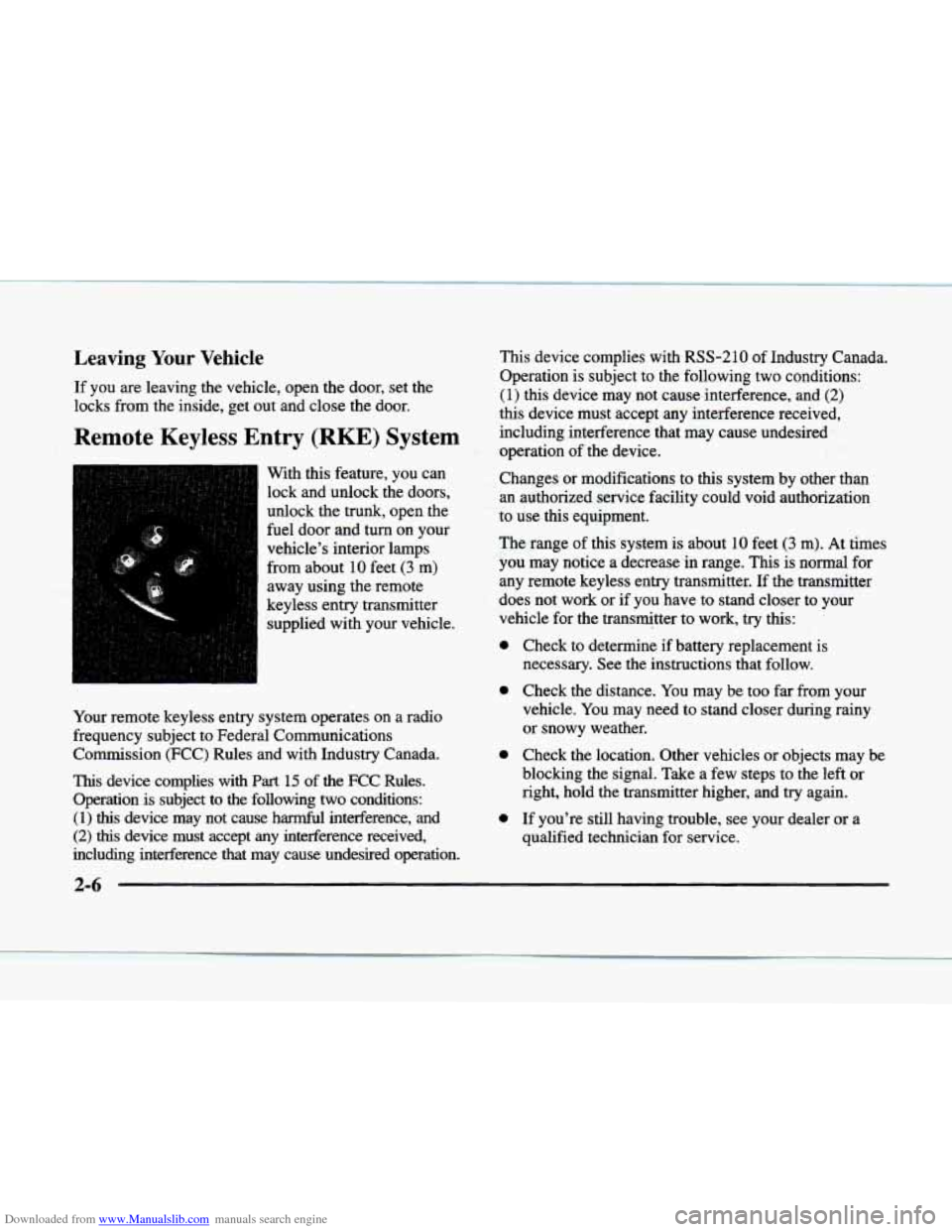
Downloaded from www.Manualslib.com manuals search engine Leaving Your Vehicle
If you are leaving the vehicle, open the door, set the
locks from the inside, get out and close the door.
Remote Keyless Entry (RKE) System
With this feature, you can
lock and unlock the doors,
unlock the
trunk, open the
fuel door and turn on your
vehicle’s interior lamps
from about
10 feet (3 m)
away using the remote
keyless entry transmitter
supplied with your vehicle.
Your remote keyless entry system operates on
a radio
frequency subject to Federal Communications
Commission (FCC) Rules and with Industry Canada.
This device complies with Part 15 of the FCC Rules.
Operation is subject to the following
two conditions:
(1) this device may not cause harmful interference, and
(2) this device must accept any interference received,
including interference that may cause undesired operation. This
device complies with
RSS-210 of Industry Canada.
Operation is subject to the following two conditions:
(1) this device may not cause interference, and (2)
this device must accept any interference received,
including interference that may cause undesired
operation of the device.
Changes or modifications to
this system by other than
an authorized service facility could void authorization
to use this equipment.
The range of this system is about
10 feet (3 m). At times
you may notice a decrease in range.
This is normal for
any remote keyless entry transmitter.
If the transmitter
does not work or if you have to stand closer to your
vehicle for the transmitter
to work, try this:
0
0
0
0
Check to determine if battery replacement is
necessary. See the instructions that follow.
Check the distance. You may be too far from your
vehicle.
You may need to stand closer during rainy
or snowy weather.
Check the location. Other vehicles
or objects may be
blocking the signal. Take a few steps to the left or
right, hold the transmitter higher, and
try again.
If you’re still having trouble, see your dealer or a
qualified technician for service.
2-6
Page 85 of 380
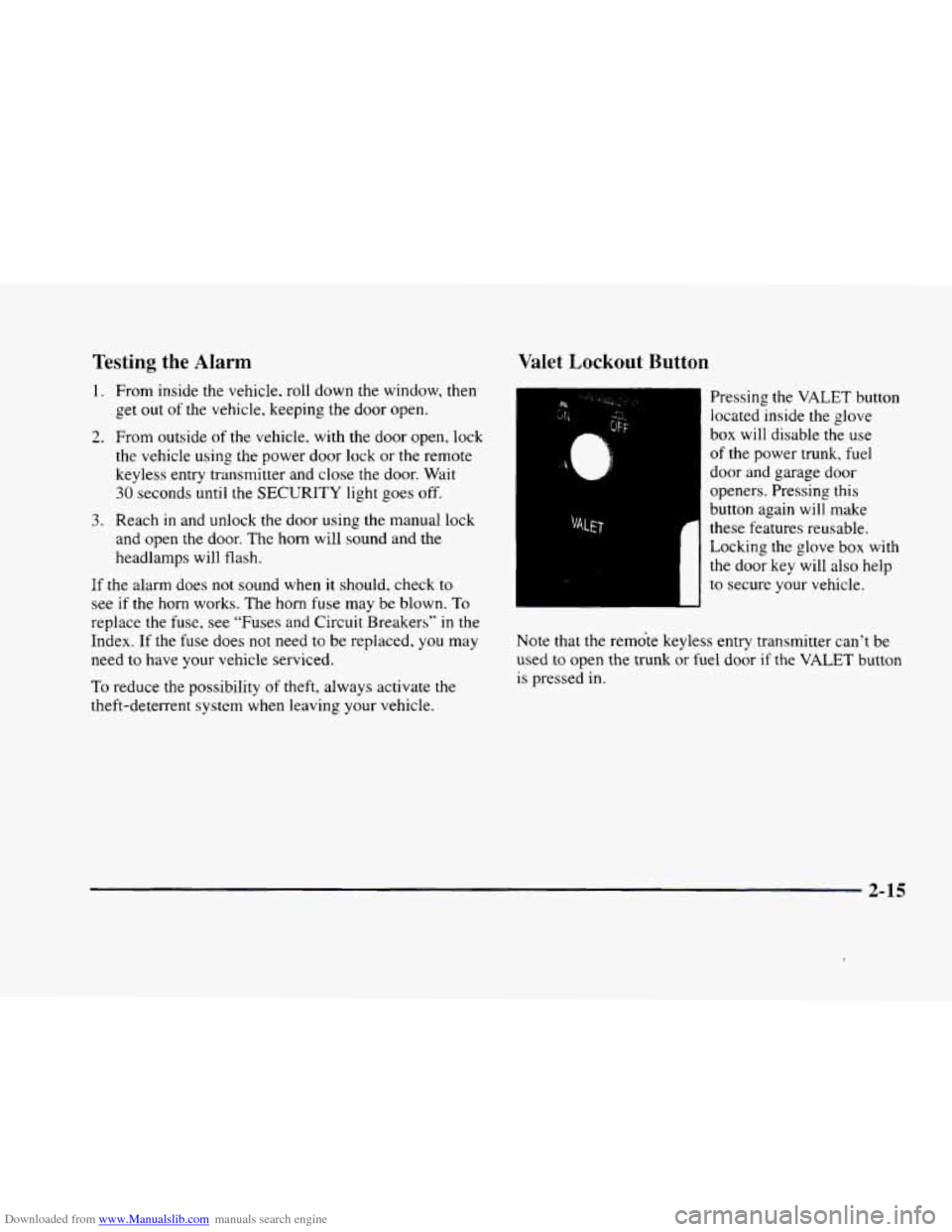
Downloaded from www.Manualslib.com manuals search engine Testing the Alarm
1. From inside the vehicle. roll down the window, then
get
out of the vehicle, keeping the door open.
2. From outside of the vehicle, with the door open, lock
the vehicle using the power door lock
or the remote
keyless entry transmitter and close the door. Wait
30 seconds until the SECURITY light goes off.
3. Reach in and unlock the door using the manual lock
and open the door. The
horn will sound and the
headlamps will flash.
If the alarm does not sound when it should, check to
see if the horn works. The horn fuse may be blown. To
replace the fuse, see "Fuses and Circuit Breakers" in the
Index.
If the fuse does not need to be replaced, you may
need to have
your vehicle serviced.
To reduce the possibility of theft, always activate the
theft-deterrent system when leaving your vehicle.
Valet Lockout Button
Pressing the VALET button
located inside the glove
box will disable the use
of the power trunk, fuel
door and garage door
openers. Pressing this
button again will make
these features reusable.
Locking the glove box with
the door key will also help
to secure your vehicle.
Note that the remote keyless entry transmitter can't be
used
to open the trunk or fuel door if the VALET button
is pressed in.
2-15
Page 86 of 380
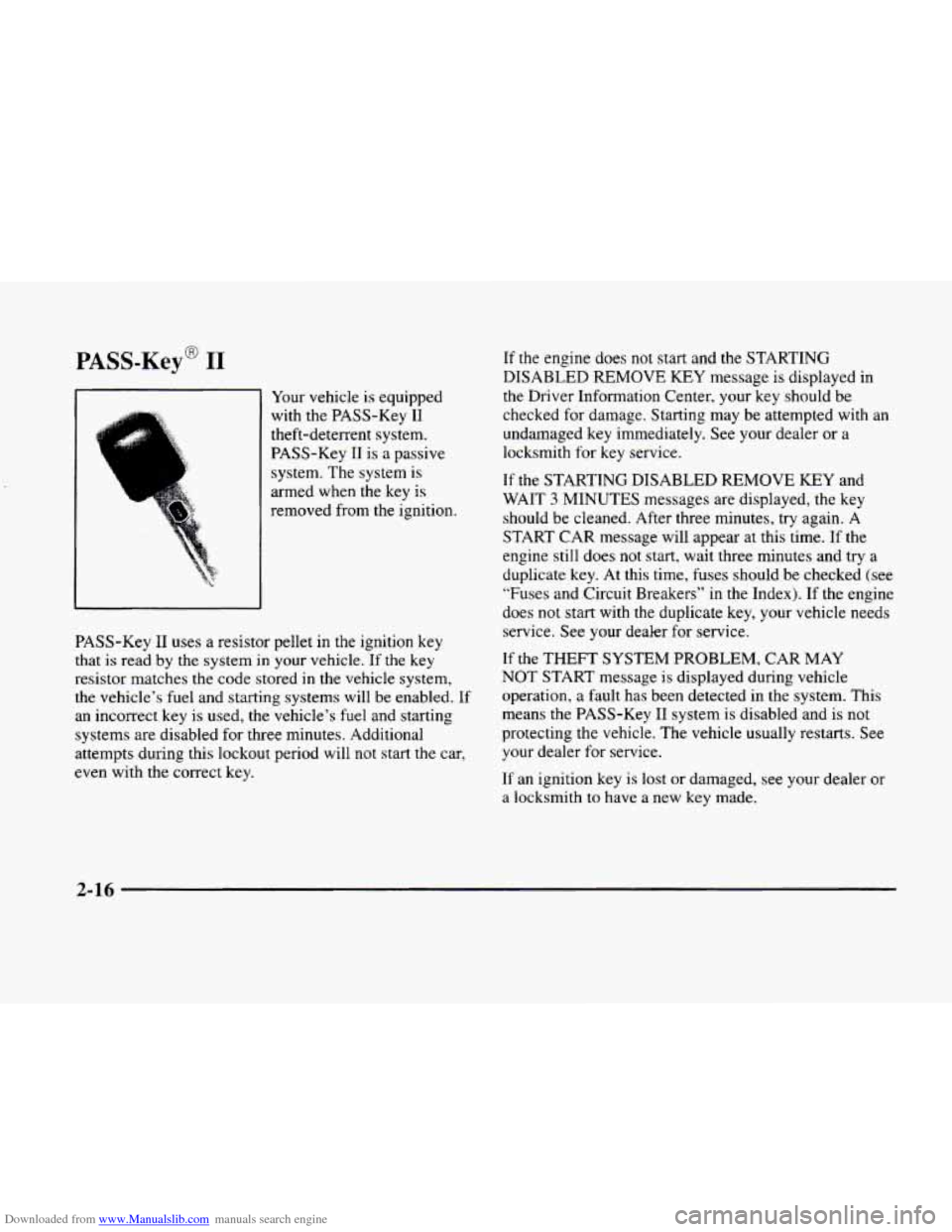
Downloaded from www.Manualslib.com manuals search engine PASS-Key@ I1
Your vehicle is equippea
with the PASS-Key
I1
theft-deterrent system.
PASS-Key
I1 is a passive
system. The system is
armed when the key is
removed from the ignition.
PASS-Key
I1 uses a resistor pellet in the ignition key
that
is read by the system in your vehicle. If the key
resistor matches the code stored in the vehicle system,
the vehicle’s fuel and starting systems will be enabled.
If
an incorrect key is used, the vehicle’s fuel and starting
systems are disabled for three minutes. Additional
attempts during this lockout period will not start the car,
even with the correct key. If
the engine does
not start and the STARTING
DISABLED REMOVE
KEY message is displayed in
the Driver Information Center. your key should be
checked for damage. Starting may be attempted with an
undamaged key immediately. See your dealer or a
locksmith for key service.
If the STARTING DISABLED REMOVE
KEY and
WAIT
3 MINUTES messages are displayed, the key
should be cleaned. After three minutes, try again.
A
START CAR message will appear at this time. If the
engine still does not start, wait three minutes and try a
duplicate key. At this time, fuses should be checked (see
“Fuses and Circuit Breakers”
in the Index). If the engine
does
not start with the duplicate key, your vehicle needs
service. See your dealer for service.
If the THEFT SYSTEM PROBLEM, CAR MAY
NOT START message is displayed during vehicle
operation, a fault has been detected
in the system. This
means the PASS-Key
I1 system is disabled and is not
protecting the vehicle. The vehicle usually restarts. See
your dealer for service.
If an ignition key is lost or damaged, see your dealer or
a locksmith
to have a new key made.
2-16
Page 90 of 380
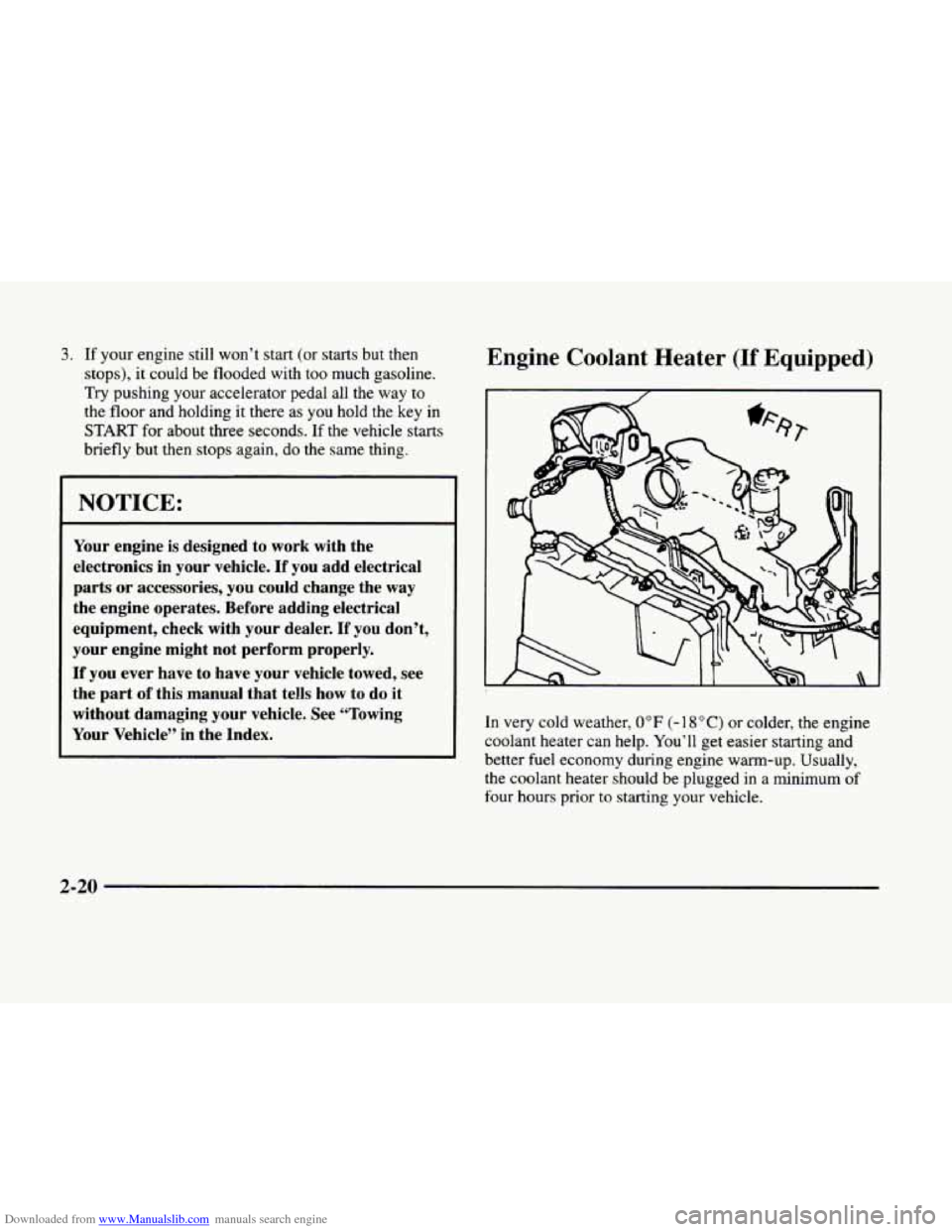
Downloaded from www.Manualslib.com manuals search engine 3. If your engine still won’t start (or starts but then
stops), it could be flooded with too much gasoline.
Try pushing your accelerator pedal all the way to
the floor and holding it there as you hold the key in
START for about three seconds. If the vehicle starts
briefly but then stops again, do the same thing.
NOTICE: I
Your engine is designed to work with the
electronics in your vehicle.
If you add electrical
parts
or accessories, you could change the way
the engine operates. Before adding electrical
equipment, check with your dealer.
If you don’t,
your engine might not perform properly.
If you ever have to have your vehicle towed, see
the part
of this manual that tells how to do it
without damaging
your vehicle. See “Towing
Your Vehicle”
in the Index.
Engine Coolant Heater (If Equipped)
In very cold weather, 0°F (- 18OC) or colder, the engine
coolant heater can help.
You’ll get easier starting and
better fuel economy during engine
warm-up. Usually,
the coolant heater should be plugged in a minimum of
four hours prior to starting your vehicle.
2-20
Page 103 of 380
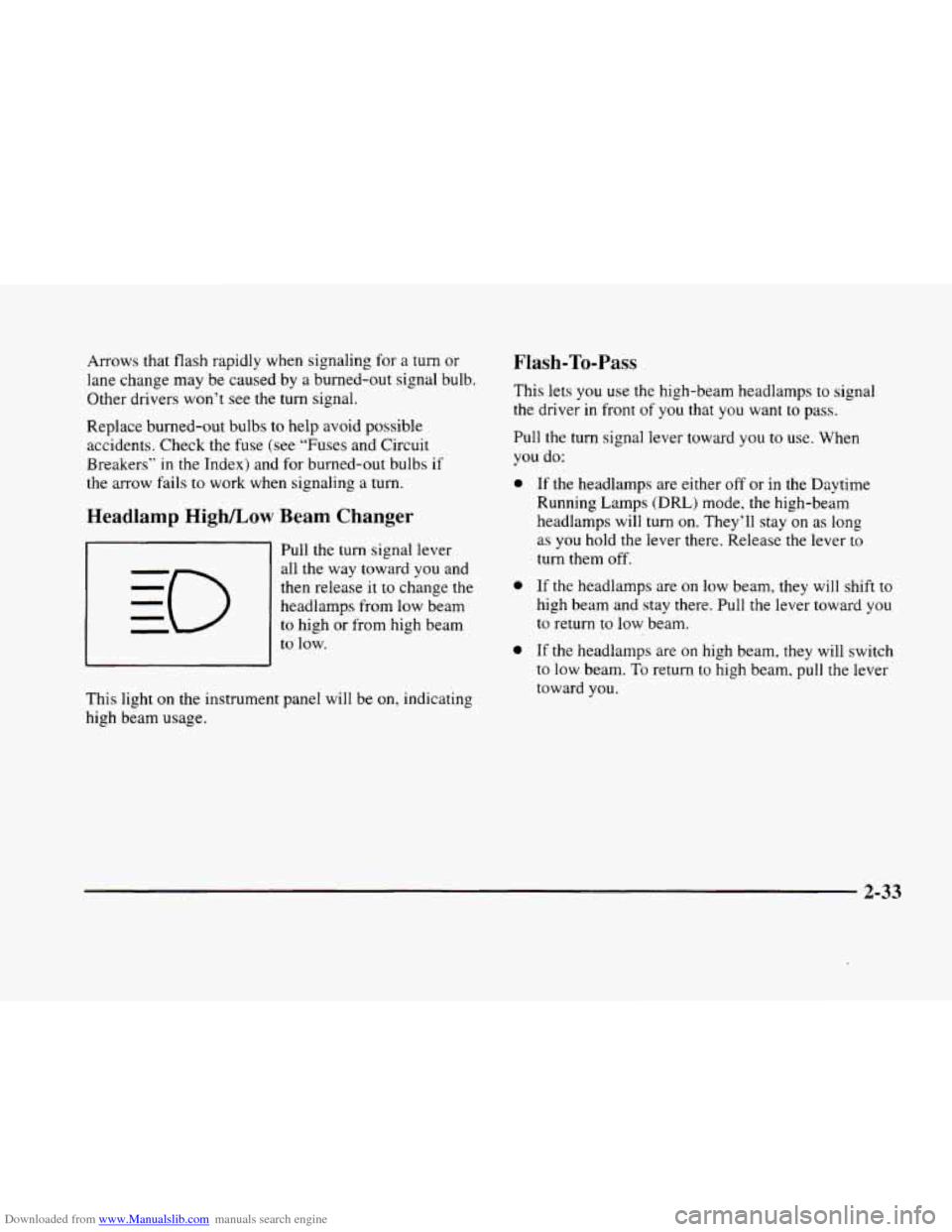
Downloaded from www.Manualslib.com manuals search engine Arrows that flash rapidly when signaling for a turn or
lane change may be caused by a burned-out signal bulb.
Other drivers won’t see
the turn signal.
Replace burned-out bulbs
to help avoid possible
accidents. Check the fuse
(see “Fuses and Circuit
Breakers”
in the Index) and for burned-out bulbs if
the arrow fails to work when signaling a turn.
Headlamp High/Low Beam Changer
Pull the turn signal lever
all the way toward
you and
then release it
to change the
headlamps from low beam
to high or from high beam
to low.
This light
on the instrument panel will be on, indicating
high beam usage.
Flash-To-Pass
This lets you use the high-beam headlamps to signal
the driver in front
of you that you want to pass.
Pull the
turn signal lever toward you to use. When
you do:
0
0
0
If the headlamps are either off or in the Daytime
Running Lamps
(DRL) mode, the high-beam
headlamps will turn
on. They’ll stay on as long
as you hold the lever there. Release the lever to
turn them off.
If the headlamps are
on low beam, they will shift to
high beam and stay there. Pull the lever toward you
to return to low beam.
If the headlamps are
on high beam, they will switch
to low beam.
To return to high beam. pull the lever
toward you.
2-33
Page 106 of 380

Downloaded from www.Manualslib.com manuals search engine NOTICE:
Driving without washer fluid can be dangerous.
A bad mud splash can block your vision and you
could hit another vehicle or go off the road.
Check the washer fluid level often.
J
Cruise Control
With cruise control, you can maintain a speed of about
25 mph (40 km/h) or more without keeping your foot
on the accelerator. This can help on long trips.
Cruise control does
not work at speeds below
25 mph (40 kd).
Cruise control shuts off when you apply your brakes.
A CAUTION:
Cruise control can be dangerous where you
can’t drive safely at
a steady speed. So,
don’t use your cruise control on winding
roads or in heavy traffic.
slippery roads. On such roads, fast changes
in tire traction can cause needless wheel
spinning, and you could
lose control. Don’t
use cruise control on slippery roads.
Cruise control can be dangerous on
If your vehicle is in cruise control when the traction
control system begins
to limit wheel spin, the cruise
control will automatically disengage. (See “Traction
Control System” in
the Index.) When road conditions
allow you
to safely use it again, you may turn the
cruise control back
on.
2-36